0 引言
煤是一种多孔介质,其孔隙结构直接影响煤中瓦斯富集和渗透特性[1-2]。目前,煤孔隙结构表征方法主要有压汞法[3]、低温液氮吸附法[4]、扫描电镜法[5]、显微CT法[6]、小角散射法[7]等。压汞法、低温液氮吸附法可将流体侵入孔隙内表面,但测量的孔径范围存在很大差异,压汞法可准确表征较大孔径的孔隙结构特征,低温液氮吸附法可准确表征较小孔径的孔隙结构特征;扫描电镜法、显微CT法、小角散射法通过图像处理可直观观察孔隙外部,但获取的孔径分布数据不具有代表性。
由于采用单一方法只能对某一孔径范围内的孔隙结构进行表征[8],联合压汞法和低温液氮吸附法分析煤全孔径分布特征得到广泛应用。江泽标等[9]利用低温液氮吸附试验与压汞试验相结合的方法对CO2致裂前后的煤岩孔隙变化进行定量表征;郝晋伟等[10]基于IUPAC孔隙分类方案,联合使用压汞法、低温液氮吸附法对不同尺度的孔隙结构进行测试,将测试数据进行插值处理,从而获得构造煤孔隙结构的全孔径分布数据;林海飞等[11]采用同孔径处比表面积增量或孔体积增量差值最小的方法,将压汞法和低温液氮吸附法下孔径分布数据进行联合,分析了煤样全孔径段孔隙结构特征;何珊[12]以低温液氮吸附法和压汞法的优势孔径段临界值为连接点,对测量数据进行连接,从而实现煤样全孔径孔隙结构的有效表征。煤基质具有很强的可压缩性,当孔隙内压力增加时,煤基质产生变形甚至破坏,这种现象称为煤基质压缩效应[13-15]。然而上述研究均未考虑煤基质压缩效应对孔径分布测量结果的影响。因此,本文联合压汞法和低温液氮吸附法对不同变质程度煤样进行孔隙结构参数测定,计算煤基质压缩性系数,对孔径分布数据进行校正,进而采用联孔分析原则实现煤全孔径分布特征准确表征。
1 煤样选取及基础参数测定
实验所用4种煤样分别取自阜康矿区的东风福胜矿和鑫龙矿、彬长矿区的小庄矿及澄合矿区的合阳矿,取样煤层均为正在开采煤层。东风福胜矿地处二工河-黄山倒转向斜的东端,鑫龙矿位于阜康市甘河子镇以南7 km处,阜康矿区煤层赋存于侏罗系下统八道湾组地层,组内可采最大瓦斯含量为5.811 m3/t,瓦斯垂直分带位于-170~-450 m。小庄矿地处彬长矿区东部,煤层位于侏罗系中统延安组第一段,主采的4号煤层平均厚度为18.01 m,绝对瓦斯涌出量为4.11 m3/min。合阳矿地处渭北石炭二叠纪煤田,主采的5号煤层埋藏深度为520 m左右,平均厚度为3.5 m,矿井瓦斯含量较低,主要富含贫瘦煤。将采集的煤样密封保存,分别进行工业分析、显微分析和镜质组反射率测定,结果见表1。
表1 煤样基础参数测定结果
Table 1 Test results of basic parameters of coal samples

煤样编号采样地点水分/%灰分/%挥发分/%固定碳/%镜质组/%惰质组/%壳质组/%真密度/(g·cm-3)最大镜质组反射率/%煤阶1号东风福胜矿2.094.4137.5858.4251.0044.604.401.267 90.53长焰煤2号小庄矿4.7115.6832.2650.5533.6064.801.601.332 60.65不黏结煤3号鑫龙矿0.9114.3639.7151.1668.5028.403.101.432 40.76气煤4号合阳矿0.248.6413.0379.2681.1711.827.011.431 71.99瘦煤
2 压汞实验数据校正
2.1 低温液氮吸附和压汞实验结果对比分析
本文分别采用ASAP 2020比表面积和孔径分析仪器与AutoPoreIV 9510型全自动压汞仪器进行低温液氮吸附实验和压汞实验,2种实验测定的比表面积和孔体积分别见表2和表3(本文采用霍多特(XOJIOT)孔径划分方法,将孔径分为大孔(>1 000 nm)、中孔(100~1 000 nm)、过渡孔(10~100 nm)、微孔(<10 nm))。可看出在微孔段压汞法测得的比表面积是低温液氮吸附法测得结果的37.61~540.53倍,微孔段压汞法测得的孔体积是低温液氮吸附法测得结果的106~568倍,2种实验结果差异较大,主要原因是高压汞对煤基质造成了破坏,使得微孔测量误差增大,因此有必要对压汞实验数据进行校正。
表2 各孔径段比表面积
Table 2 Specific surface area of each aperture segment (m2·g-1)

煤样编号低温液氮吸附法压汞法微孔过渡孔中大孔微孔过渡孔中大孔1号0.038 30.130 50.022 520.702 32.054 90.028 22号0.164 70.172 60.026 323.227 82.503 90.039 83号0.167 40.159 20.028 418.934 12.106 80.069 24号0.506 50.304 10.042 519.050 22.092 00.086 8
表3 各孔径段孔体积
Table 3 Pore volume of each aperture segment (mL·g-1)
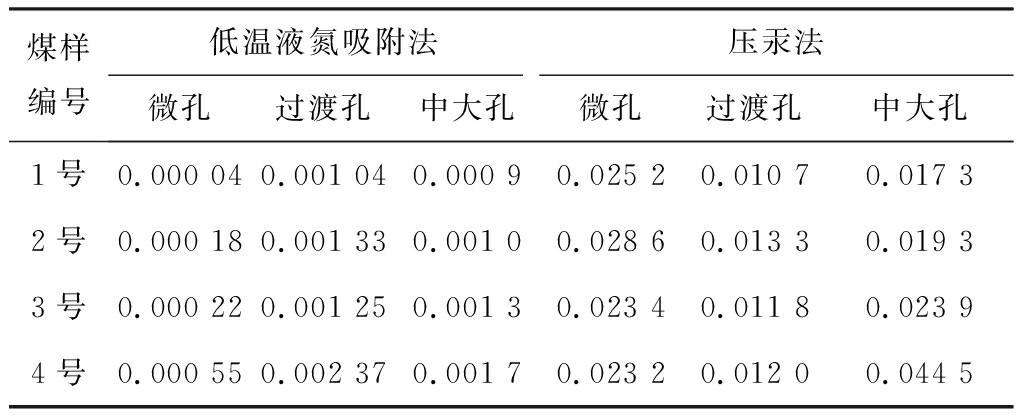
煤样编号低温液氮吸附法压汞法微孔过渡孔中大孔微孔过渡孔中大孔1号0.000 040.001 040.000 90.025 20.010 70.017 32号0.000 180.001 330.001 00.028 60.013 30.019 33号0.000 220.001 250.001 30.023 40.011 80.023 94号0.000 550.002 370.001 70.023 20.012 00.044 5
2.2 煤基质压缩性系数计算
煤基质压缩性系数是煤基质压缩效应的一个量化参数,对压汞实验数据校正前需要计算煤基质压缩性系数。假设煤基质压缩性系数是常数,根据式(1)计算煤基质压缩性系数,结果见表4。
(1)
式中:km为煤基质压缩性系数,m2/N;Vm为煤基质体积,mL/g;P为汞压,MPa。
2.3 数据校正
压汞法所测得累计进汞体积与汞压关系如图1
表4 煤基质压缩性系数
Table 4 Compressibility coefficient of coal matrix
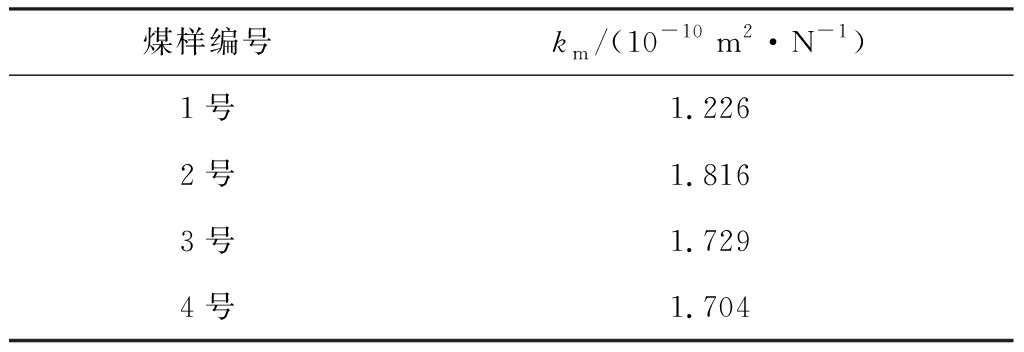
煤样编号km/(10-10 m2·N-1)1号1.2262号1.8163号1.7294号1.704
所示。当0.124 MPa≤P≤20 MPa时,累计进汞体积与汞压呈上凸递增关系,表明在该压力段内煤基质被压缩,孔隙结构发生变形,且随着汞压增加,煤基质压缩效应逐渐明显,孔隙结构变形程度逐渐增加;当20 MPa<P≤206 MPa时,累计进汞体积与汞压呈显著线性正相关关系,表明在该压力段内煤基质压缩效应显著,孔隙结构遭到破坏。因此,需要对0.124 MPa≤P≤20 MPa范围内累计进汞体积进行校正。
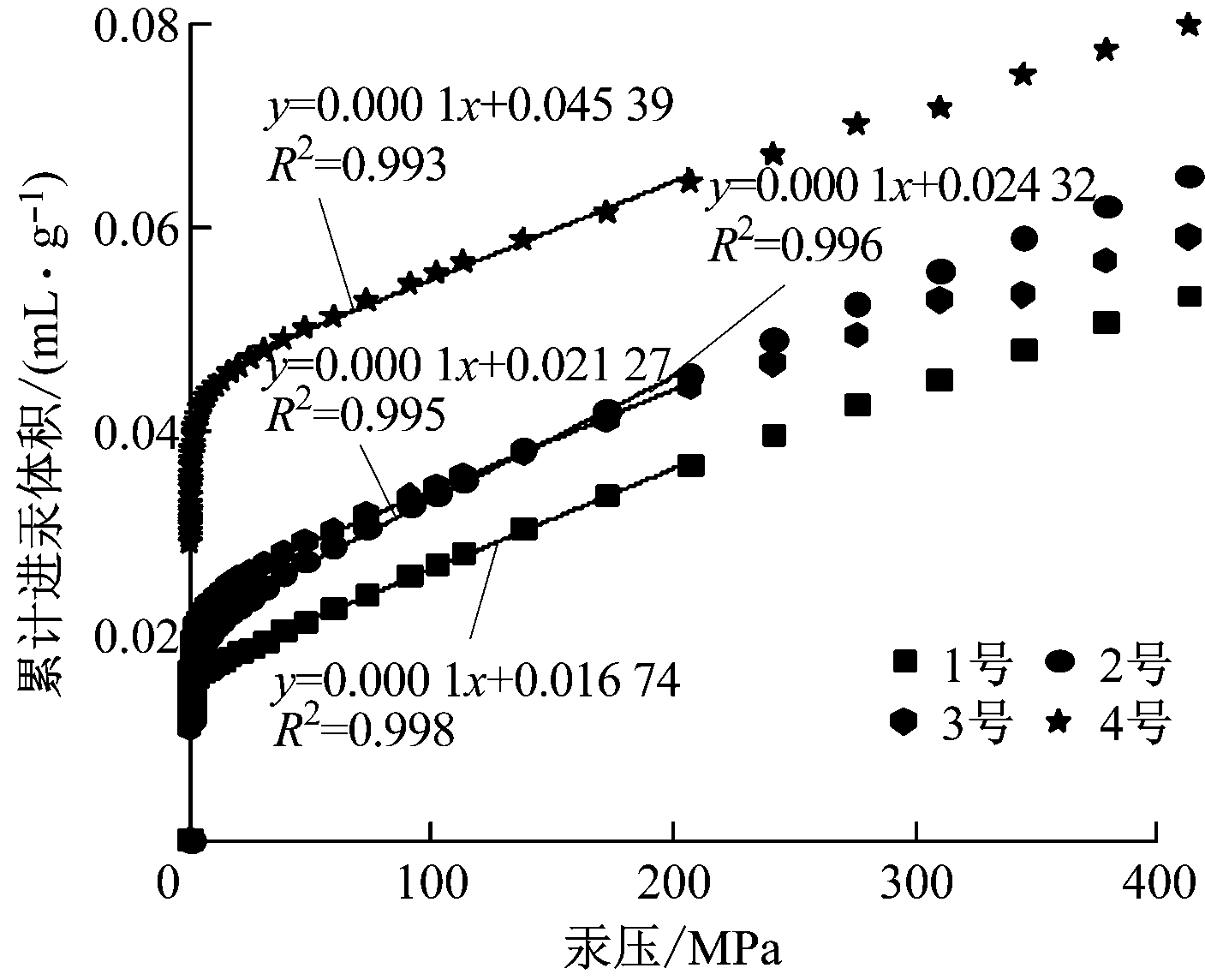
图1 累计进汞体积与汞压关系曲线
Fig.1 Relationship curve of cumulative mercury volume and mercury pressure
将累计进汞体积看作煤基质体积和孔体积2个部分之和,则
(2)
(3)
(4)
ΔVpi=Vobsi-Vobs0-kmVmi(Pi-P0)
(5)
式中:ΔVobs为累计进汞体积变化量,mL/g;ΔVobsi为第i(i=1,2,…,n,n为0.124 MPa≤P≤20 MPa内划分的压力段数)个压力段累计进汞体积变化量,mL/g;ΔVmi为第i个压力段煤基质体积变化量,mL/g;ΔVpi为第i个压力段孔体积变化量,mL/g;Pi为第i个压力段汞压,MPa;P0为初始汞压,MPa;ΔVm为煤基质体积变化量,mL/g;ΔP为汞压变化量,MPa;β为常数;ΔVp0为低温液氮吸附实验所测孔径为6~62.35 nm(根据Wasburn方程[16]计算可知,P=20 MPa对应的孔径为62.35 nm,P=206 MPa对应的孔径为6 nm)时的孔体积变化量,mL/g;Vobsi为第i个压力段累计进汞体积,mL/g;Vobs0为初始汞压下累计进汞体积,mL/g;Vmi为第i个压力段煤基质体积。
假设孔隙均为球状,比表面积变化量为
(6)
式中ΔSpi为第i个压力段比表面积变化量,m2/g。
3 煤样全孔径分布特征
3.1 联孔分析原则
联孔分析是指采用低温液氮吸附法和压汞法均能较为准确地测试出煤样孔隙结构且将测试结果在联孔分界点处进行联合。本文中联孔分界点确定为62.35 nm,采用以下联孔分析原则分析全孔径分布特征:当孔径小于62.35 nm,采用低温液氮吸附法对孔体积和比表面积进行分析;当孔径大于62.35 nm,通过对压汞实验数据校正来分析孔体积和比表面积。
3.2 全孔径比表面积分布特征
全孔径比表面积测定结果如图2所示。可看出煤样微孔比表面积为0.038 3~0.506 5 m2/g,过渡孔比表面积为0.172 8~0.370 5 m2/g,中孔比表面积为0.025 6~0.076 6 m2/g,大孔比表面积为0.002 2~0.009 6 m2/g;中低变质程度煤样(1,2,3号煤样)的比表面积以微孔和过渡孔为主,且过渡孔比表面积最大,微孔和过渡孔是影响中低变质程度煤样总比表面积的主要因素;与1,2,3号煤样相比,4号煤样各孔径段比表面积均有所增加,微孔比表面积增加幅度最大,表明微孔发育最为显著。
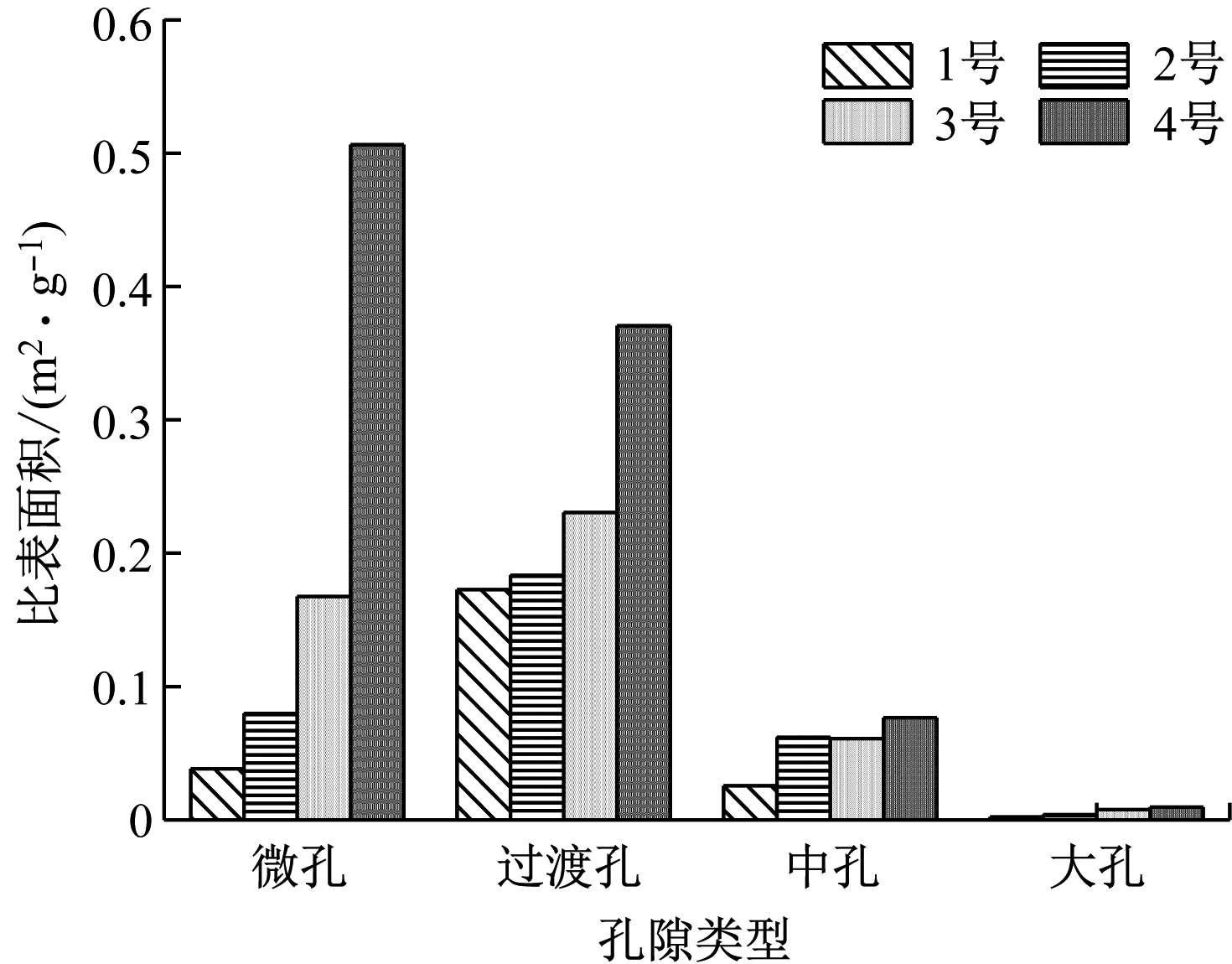
图2 全孔径比表面积
Fig.2 Specific surface area of full aperture
全孔径比表面积分布特征如图3所示。可看出各煤样比表面积分布趋势大致相同;微孔和过渡孔比表面积增量均较大,表明微孔和过渡孔对比表面积的贡献最大;随着煤样变质程度增加,微孔和过渡孔比表面积增量增幅大于中孔及大孔,表明微孔和过渡孔对比表面积的贡献率增加。
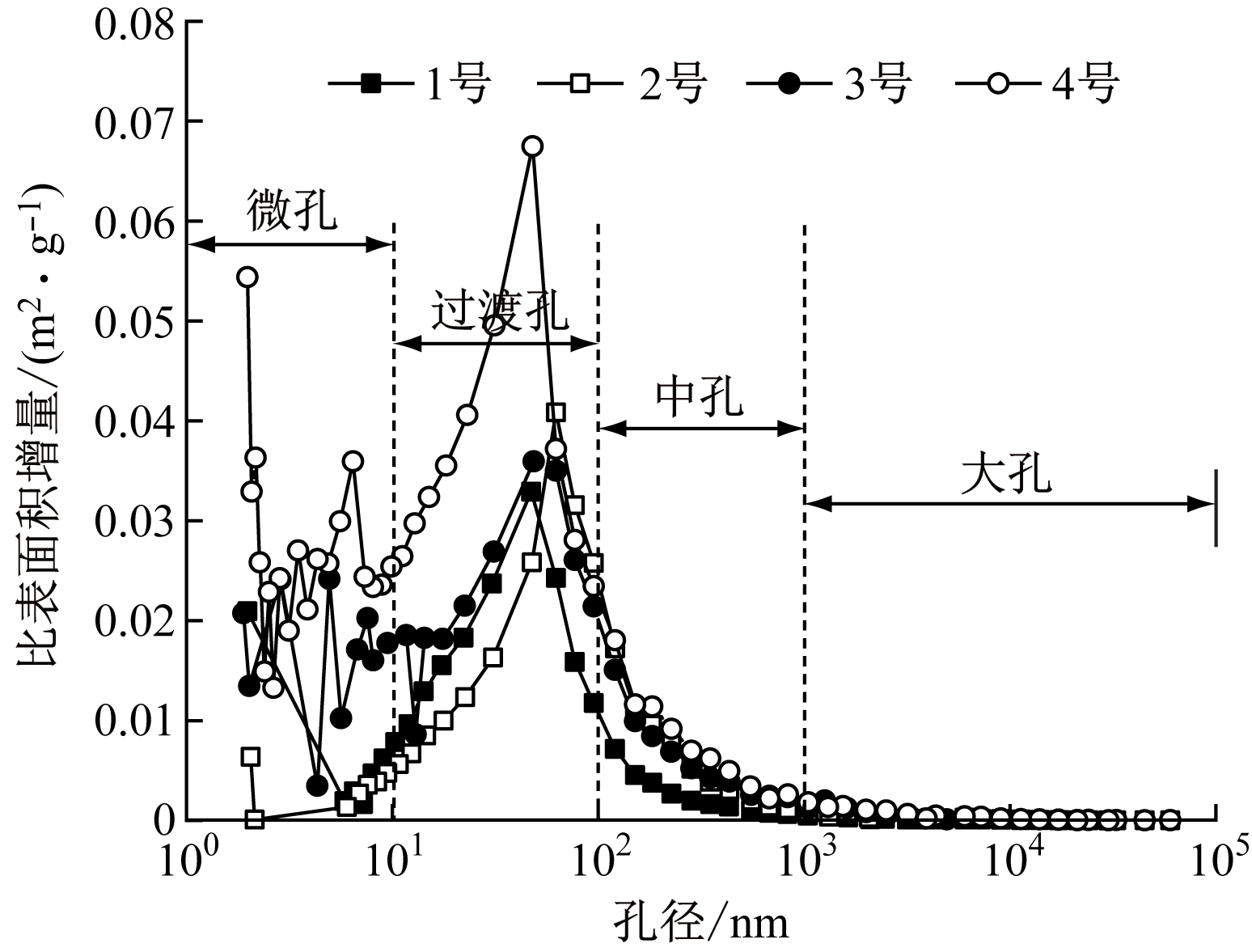
图3 全孔径比表面积分布特征
Fig.3 Distribution characteristics of specific surface area of full aperture
3.3 全孔径孔体积分布特征
全孔径孔体积测定结果如图4所示。可看出煤样微孔体积为0.000 044~0.000 554 mL/g,过渡孔体积为0.000 985~0.002 126 mL/g,中孔体积为0.000 87~0.004 51 mL/g,大孔体积为0.003 14~0.009 72 mL/g;大孔体积最大,随着孔径减小,孔体积大幅减小,中孔及大孔对孔体积起主导作用;随着煤样变质程度增加,各孔径体积均呈增大趋势,4号煤样孔体积最大。
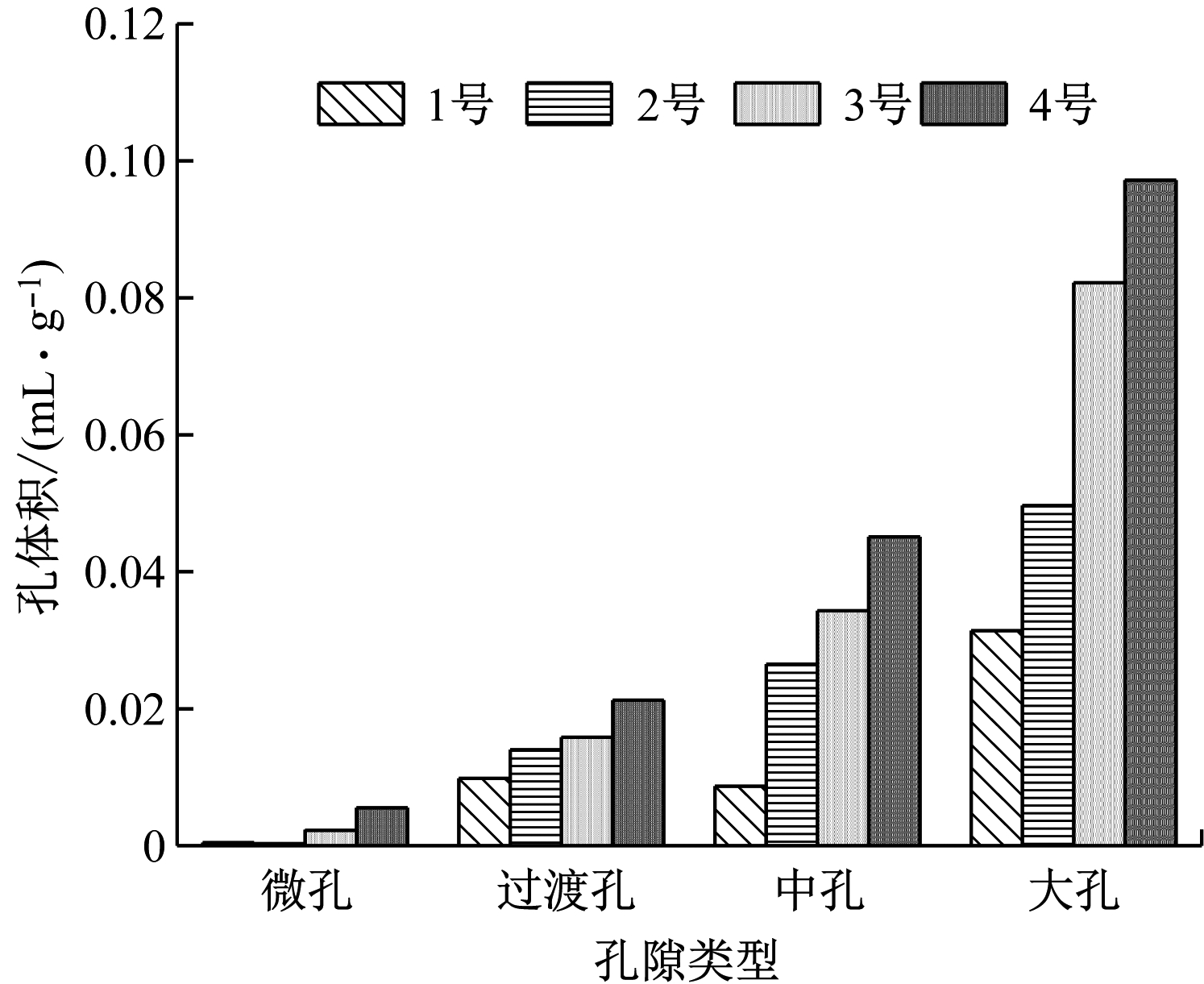
图4 全孔径孔体积
Fig.4 Pore volume of full aperture
全孔径孔体积分布特征如图5所示。可看出各孔径段孔体积增量均在波动,其中中孔及大孔体积增量波动较大,且孔体积增量均较大,表明中孔及大孔对孔体积的贡献最大;随着煤样变质程度增加,全孔径段孔体积增量增加,中孔及大孔体积增量增幅大于微孔及过渡孔,表明中孔及大孔对孔体积的贡献率增加。
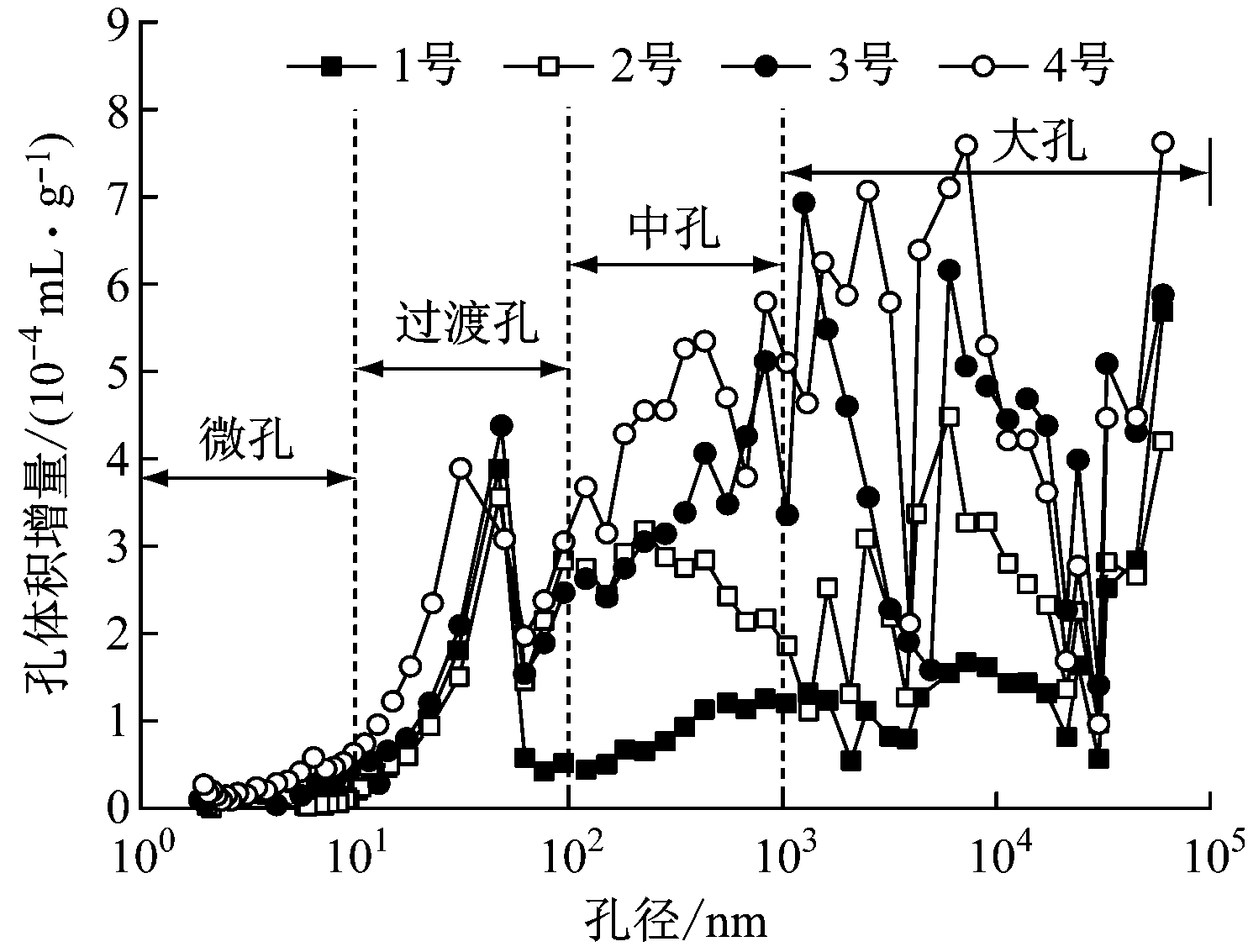
图5 全孔径孔体积分布特征
Fig.5 Distribution characteristics of pore volume of full aperture
4 结论
(1) 当汞压为0.124~20 MPa时,煤基质被压缩,孔隙结构发生变形,且随着汞压增加,煤基质压缩效应逐渐明显,孔隙结构变形程度逐渐增加;当汞压为20~206 MPa时,煤基质压缩效应显著,孔隙结构遭到破坏。
(2) 汞压为20 MPa时对应的孔径为62.35 nm,考虑煤基质压缩效应的影响,确定联孔分界点为62.35 nm。当孔径小于62.35 nm时,采用低温液氮吸附法对孔体积和比表面积进行分析;当孔径大于62.35 nm时,通过对压汞实验数据进行校正来分析孔体积和比表面积。
(3) 微孔和过渡孔对比表面积的贡献最大,中孔及大孔对孔体积的贡献最大。随着煤样变质程度增加,各孔径段比表面积和孔体积增量均增加,微孔和过渡孔对比表面积的贡献率增加,中孔及大孔对孔体积的贡献率增加。
[1] 杨明,柳磊,张学博,等.不同阶煤孔隙结构与流体特性的核磁共振试验研究[J].中国安全科学学报,2021,31(1):81-88.
YANG Ming,LIU Lei,ZHANG Xuebo,et al.Nuclear magnetic resonance experimental study on pore structure and fluid characteristics of coal at different ranks[J].China Safety Science Journal,2021,31(1):81-88.
[2] 刘彦伟,张帅,左伟芹,等.典型软硬煤全孔径孔隙结构差异性研究[J].煤炭科学技术,2021,49(10):98-106.
LIU Yanwei,ZHANG Shuai,ZUO Weiqin,et al.Study on differences of pore structure of typical soft and hard coal[J].Coal Science and Technology,2021,49(10):98-106.
[3] LI Xiangchen,KANG Yili,HAGHIGHI M.Investigation of pore size distributions of coals with different structures by nuclear magnetic resonance(NMR) and mercury intrusion porosimetry(MIP)[J].Measurement,2017,116:122-128.
[4] 张玉贵,焦银秋,雷东记,等.煤体纳米级孔隙低温氮吸附特征及分形性研究[J].河南理工大学学报(自然科学版),2016,35(2):141-148.
ZHANG Yugui,JIAO Yinqiu,LEI Dongji,et al.Study on adsorption characteristics and fractal properties of nano-scale pores at low temperature coal[J].Journal of Henan Polytechnic University(Natural Science),2016,35(2):141-148.
[5] 杨昌永,常会珍,邵显华,等.扫描电镜下不同煤体结构煤微孔隙特征研究[J].煤炭科学技术,2019,47(12):194-200.
YANG Changyong,CHANG Huizhen,SHAO Xianhua,et al.Study on micro-pore characteristics of structural coal in different coal bodies under scanning electron microscopy[J].Coal Science and Technology,2019,47(12):194-200.
[6] 张磊.基于高精度显微CT技术的煤微观孔隙结构特征研究[D].青岛:山东科技大学,2016.
ZHANG Lei.Coal microscopic pore features study based on high-resolution micro-CT technology[D].Qingdao:Shandong University of Science and Technology,2016.
[7] 聂百胜,王科迪,樊堉,等.基于小角X射线散射技术计算不同孔形的煤孔隙特征比较研究[J].矿业科学学报,2020,5(3):284-290.
NIE Baisheng,WANG Kedi,FAN Yu,et al.The comparative study on calculation of coal pore characteristics of different pore shapes based SAXS[J].Journal of Mining Science and Technology,2020,5(3):284-290.
[8] FAN Chaojun,ELSWORTH D,LI Sheng,et al.Thermo-hydro-mechanical-chemical couplings controlling CH4 production and CO2 sequestration in enhanced coalbed methane recovery[J].Energy,2019,173:1054-1077.
[9] 江泽标,彭鑫,韦善阳,等.基于氮吸附、压汞联合试验的CO2致裂对煤岩孔隙的影响[J].安全与环境学报,2021,21(1):101-108.
JIANG Zebiao,PENG Xin,WEI Shanyang,et al.Influence of CO2 cracking on the coal and rock pore based on the nitrogen adsorption and mercury press combined experiment[J].Journal of Safety and Environment,2021,21(1):101-108.
[10] 郝晋伟,李阳.构造煤孔隙结构多尺度分形表征及影响因素研究[J].煤炭科学技术,2020,48(8):164-174.
HAO Jinwei,LI Yang.Research on multi-scale fractal characteristics of pore structure in tectonic coal and analysis of its influence factors[J].Coal Science and Technology,2020,48(8):164-174.
[11] 林海飞,卜婧婷,严敏,等.中低阶煤孔隙结构特征的低温液氮吸附法和压汞法联合分析[J].西安科技大学学报,2019,39(1):1-8.
LIN Haifei,BU Jingting,YAN Min,et al.Joint analysis of pore structure characteristics of middle and low rank coal with nitrogen adsorption and mercury intrusion method[J].Journal of Xi'an University of Science and Technology,2019,39(1):1-8.
[12] 何珊.煤岩甲烷高压吸附特性及其影响因素研究[D].北京:中国地质大学(北京),2020.
HE Shan.The characteristic and influencing factors of high-pressure methane adsorption on dry coals[D].Beijing:China University of Geosciences(Beijing),2020.
[13] 肖鹏,杜媛媛.构造煤微观结构对其吸附特性的影响实验[J].西安科技大学学报,2021,41(2):237-245.
XIAO Peng,DU Yuanyuan.Experiment on the influence of microstructure of tectonic coal on its adsorption characteristics[J].Journal of Xi'an University of Science and Technology,2021,41(2):237-245.
[14] 李阳,张玉贵,张浪,等.基于压汞、低温N2吸附和CO2吸附的构造煤孔隙结构表征[J].煤炭学报,2019,44(4):1188-1196.
LI Yang,ZHANG Yugui,ZHANG Lang,et al.Characterization on pore structure of tectonic coals based on the method of mercury intrusion,carbon dioxide adsorption and nitrogen adsorption[J].Journal of China Coal Society,2019,44(4):1188-1196.
[15] 李希建,薛海腾,陈刘瑜,等.贵州地区突出煤层微孔结构及对瓦斯流动特性的影响[J].煤炭科学技术,2020,48(10):67-74.
LI Xijian,XUE Haiteng,CHEN Liuyu,et al.Micropore structure of outburst coal seam in Guizhou Area and its effect on gas flow[J].Coal Science and Technology,2020,48(10):67-74.
[16] LI Yonghua,LU Gaoqing,RUDOLPH V.Compressibility and fractal dimension of fine coal particles in relation to pore structure characterisation using mercury porosimetry[J].Particle and Particle Systems Characterization,1999,16(1):25-31.
